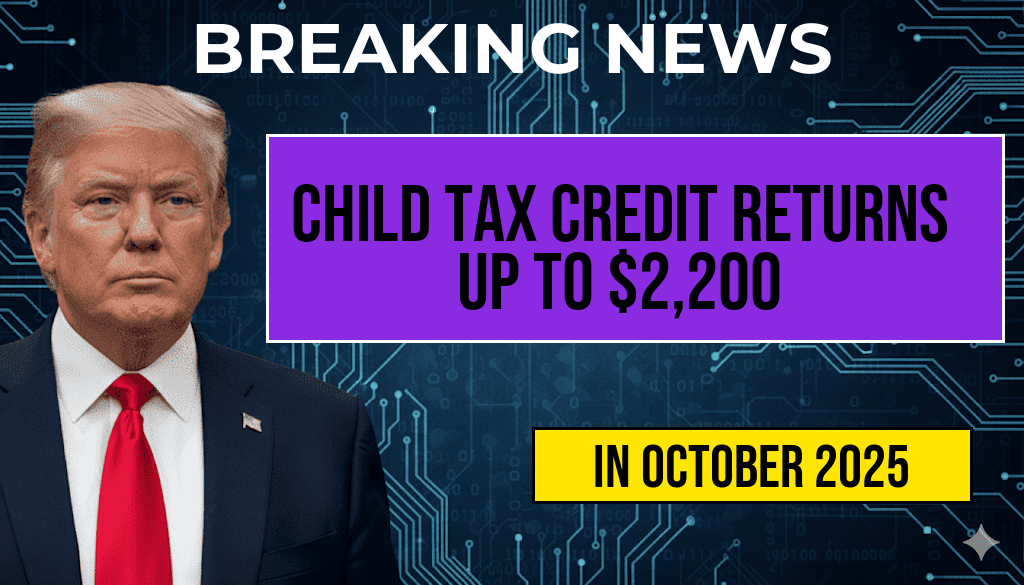Starting next year, millions of American families will have the opportunity to receive increased financial relief through the resumption of the Child Tax Credit. Eligible households can now claim up to $2,200 per qualified child, marking a significant boost from previous years. This change comes as part of ongoing efforts to support families amid economic shifts, with the credit designed to help offset the costs associated with raising children. The updated credit amounts are set to benefit families across the country, especially those in lower and middle-income brackets, providing an essential financial cushion. Policymakers have emphasized the importance of this measure in reducing child poverty and promoting economic stability for families. For many, this means a welcome increase in monthly income, helping cover essentials such as education, healthcare, and daily needs.
Understanding the New Child Tax Credit Structure
What Families Can Expect in 2024
The revised Child Tax Credit will offer up to $2,200 per qualified child under the age of 17. Unlike the temporary enhancements seen during the pandemic, the upcoming changes are part of a permanent adjustment to the credit’s base amount. This means families will see a consistent benefit each tax year, simplifying planning and budgeting efforts. The increased amount is intended to provide more substantial support, especially for families with multiple children.
Eligibility Criteria and Income Limits
| Criteria | Details |
|---|---|
| Child Age | Under 17 years old at the end of the tax year |
| Income Limits | Phase-out begins at $75,000 for single filers; $150,000 for married filing jointly |
| Filing Status | Must be claimed as a dependent on the taxpayer’s return |
| Residency | Child must live with the taxpayer for more than half the year |
While the maximum benefit is $2,200 per child, the actual amount a family receives depends on income and filing status. The credit begins to phase out once income exceeds specified thresholds, reducing the benefit gradually until it is eliminated at higher income levels.
How the Child Tax Credit Impacts Families
Financial Relief and Poverty Reduction
The reinstatement of the full Child Tax Credit amount is expected to provide significant financial relief to millions of households. According to estimates from the Tax Policy Center, the increase could lift approximately 4 million children out of poverty. The extra funds can be used to cover everyday expenses such as groceries, clothing, or healthcare, alleviating some of the financial burdens that families face.
Tax Filing and Advance Payments
Families can claim the Child Tax Credit when they file their annual tax returns. Additionally, the IRS has announced the continuation of advance monthly payments during 2024, allowing eligible families to receive part of the credit throughout the year. These payments are designed to provide ongoing support rather than waiting for a lump sum at tax time. Eligible families should ensure their details are up to date in IRS systems to receive these payments promptly.
Policy Context and Future Outlook
Legislative Background
The current enhancements to the Child Tax Credit stem from temporary measures introduced during the COVID-19 pandemic, which included increased amounts and expanded eligibility. Legislation passed in late 2023 has made some of these changes permanent, reflecting a bipartisan recognition of the importance of supporting families with children. The new framework aims to create a more predictable and accessible benefit system that aligns with ongoing economic realities.
Potential for Further Expansion
Advocates continue to push for additional reforms, including increasing the maximum credit amount and expanding eligibility to more families. Some policymakers suggest linking the credit to inflation adjustments to maintain its real value over time. Experts note that these measures could further reduce child poverty rates and promote long-term economic stability.
Resources and Next Steps
Families interested in understanding their eligibility or how to claim the Child Tax Credit should consult the official IRS resources, including the IRS Child Tax Credit page. Tax professionals can also provide personalized guidance, especially for families with complex financial situations. As the 2024 tax season approaches, ensuring accurate information and timely filing will be crucial to maximize benefits.
For further details on the history and policy implications of the Child Tax Credit, readers can refer to reputable sources such as Wikipedia or Forbes.
Frequently Asked Questions
What is the maximum Child Tax Credit amount families can receive next year?
Families can receive up to $2,200 per qualified child through the Child Tax Credit next year.
Who qualifies as a “qualified child” for the Child Tax Credit?
A qualified child typically includes children under age 17 who meet certain relationship, residency, and income requirements set by the IRS.
How will families receive the Child Tax Credit payments?
Eligible families can receive the Child Tax Credit as direct payments, either through monthly advances or as a lump sum when filing their tax return.
Are there income limits to qualify for the Child Tax Credit?
Yes, the income limits determine the amount of the credit; higher-income families may receive reduced or no credit if they exceed certain thresholds.
When can families expect to receive the Child Tax Credit next year?
Families can expect to start receiving Child Tax Credit payments early next year, with details provided by the IRS and tax agencies closer to the tax filing season.






